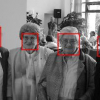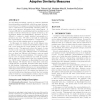322 search results - page 5 / 65 » Learning consumer preferences using semantic similarity |
CVPR
2008
IEEE
14 years 11 months ago
2008
IEEE
The required amount of labeled training data for object detection and classification is a major drawback of current methods. Combining labeled and unlabeled data via semisupervise...
IEAAIE
2010
Springer
13 years 7 months ago
2010
Springer
It is desirable to ensure that the thermal comfort conditions in offices are in line with the preferences of occupants. Controlling their offices correctly therefore requires the c...
JODS
2006
13 years 9 months ago
2006
This paper addresses the various facets of emergent semantics in content retrieval systems such as Knowledge Sifter, an architecture and system based on the use of specialized agen...
KDD
2007
ACM
14 years 10 months ago
2007
ACM
It is becoming increasingly common to construct databases from information automatically culled from many heterogeneous sources. For example, a research publication database can b...
ACL
2009
13 years 7 months ago
2009
In this paper, we analyze the impact of different automatic annotation methods on the performance of supervised approaches to the complex question answering problem (defined in th...


